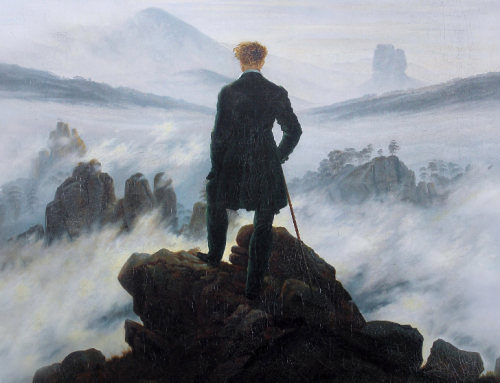Sadly, the human mind has a limited knowledge capacity. So why then do our schools continue to waste student’s valuable brainpower on outdated paradigms and extinct scientific rationale? Without even qualifying these dated lessons as science history or as a step in the progress of science, we are building scientific scaffolding in the minds of our young students that leads them to build a incorrect view of our world. Even more frightening, it could prevent our future generations from being able to progress our scientific understanding.
I will consent with Isaac Newton’s sentiment that, ” we stand on the shoulders of giants,” but even Newton himself formulated most of his theories by inventing entirely new types of mathematics and physical theory. Many scientific advances are not linear steps in scientific progress. In fact, the most astounding discoveries of all time have contradicted conventional science and disproved a history’s worth of thinkers. Einstein’s Annus Mirabilis papers, which revolutionized the world of physics, had exactly zero references. Einstein’s descriptions of special and general relativity, Brownian motion, the photoelectric effect, and matter-energy equivalence all simply end after he finishes his arguments. There is no bibliography or cited sources because he had none. His thought was original yet contradictory to the modern thought of that day. This was the type of discovery that invoked comments like, “after this every textbook in the world will need to be changed.” But they didn’t change the books. Most high-school students still study gravity as a Newtonian force rather than as an warping of space-time. And similarly, many people still believe there is a distinct difference between matter and energy, even though E=MC^2 is probably the most famous equation of all time. Some may argue that these concepts are too complicated for our students to understand, but that might be a assessment warped by the pre-conditioned minds of our educators.
Another area struggling to break apart the scaffolding of a aged paradigm is particle physics. No better example of the loss of understanding due to an aged model of reality is there than the classroom explanation of the atom. In almost every classroom across the country, the atom is described as a “mini solar system,” with the nucleus (made of protons and neutrons) in the middle and electrons spinning around it. I have seen many people stumble over this model because it makes them ask the wrong questions. They then ask why the atom is mostly empty space and if they were small enough could they stick their hand into an atom, or perhaps they ask if we can determine the path of the electron and how fast it is going. These questions are only useful in that they expose the inaccuracy of this model of the atom because this model makes people think of the atom in terms of solid objects and Newtonian motion. Instead, the atom is ruled by quantum mechanics. Quantum Mechanics does not operate like the physical world at the human scale, there is uncertainty of location and momentum, particles are constantly popping in and out of existence and they are often refereed to as realms of possibility rather that definite objects. Quantum physics also tells us that electrons, protons and neutrons aren’t even the building blocks of matter but instead there are things called quarks, which come in pairs of 3’s are considered the foundational building blocks of matter. The award-winning physicist, Sean Carroll, claims that the main reason so many people struggle with particle physics is because of the name itself. Physics at the very small scale is more about fields than particles and it the excitement of these fields that we call particles. Without understanding physics in this manner we run into infinities and misunderstanding. Perhaps, if students were introduced to this type of thinking from their introduction to the subject, they would have a easier time understanding its principles. And with this foundational understanding, perhaps these students will grow up to make the new greatest discoveries of human history.
We could be robbed of these discoveries if we continue to “dumb down” complicated topics to make them more accessible or enjoyable. How much more enjoyable and truer would a classroom be that aimed to teach students the cutting edge? Not to say that students will be able to understand everything out at the edge but at least the fundamental truths of that frontier can be conveyed.
Evolution brings us another example. Most students are taught that evolution by natural selection is a force that works on the scale of organisms. However, any biologist working on the edge of this frontier would tell you that the most accepted view among their peers is that natural selection works on the level of genes. Richard Dawkins tried to make this point very clear with his book, ” The Selfish Gene.” But still, we can hear the echoes of students reciting Charles Darwin’s catchphrase, “survival of the fittest.” What incredible depth of understanding could we reach if we simply added one word at the end to make the phrase, “survival of the fittest gene?”
I cant even count how many times in school I was forced to learn the long method for solving a problem or I was discouraged from arriving at an answer in a improper manner. And while there is merit in learning how we originally arrived at the answers, there might be more utility in understanding where we are now. I remember taking calculus in high school and my professor told me about how if we continued to pursue mathematics, we might one day learn Einstein’s theory that proposed that time travel is possible. I was excited but also upset because I was taught that time was a constant my whole life. I was enamored with the idea that time could be slowed or sped up but confused why I hadn’t been told sooner. These are the ideas that inspire our youth, the edge where science fiction becomes science fact. All young scientists dream about these ideas and we should encourage them like we did in the days of Apollo that brought an intellectual revolution to our whole world. As for me, I dream that we will once again be a society that teters on that jagged edge of fact and fiction.




Leave A Comment